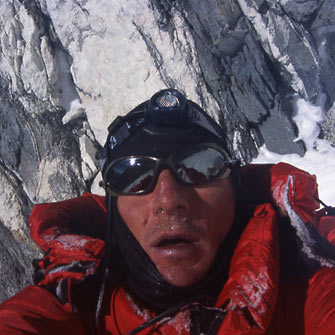
Jean-Christophe Lafaille on his December 2004 solo ascent of the British Route on the southwest face of Shishapangma. Lafaille was completely alone during his ascent, which he accomplished over the course of a month. [Photo] Jean-Christophe Lafaille
For years, I’ve had a rather simple idea in my head: to solo a big wall in the pitiless conditions of the Himalayan winter. Over the course of my travels in the Alps, ever since my first encounter with the Himalaya’s high summits, I’ve contemplated the possibility of such a project. In my approach to alpinism, I keep one central thought continually in mind: “Things always appear impossible until you’ve tried them.”
The idea seems simple on paper, but in reality it was difficult to achieve. In spite of my high-altitude experience, as I got on the plane to Kathmandu, many uncertainties preoccupied me: What effort could I make in the thin, glacial air? Could I climb a great, technical rock face fast enough between the windstorms? Yan Giezendanner, my meteorologist, had warned me that the jet stream poised over the Himalaya this season would leave me only a very short window.
I arrived in base camp on November 14. On December 9, after a period of acclimatization disturbed by the altitude’s high winds, I began my final ascent. I climbed to 7000 meters and prepared my bivouac. On December 10, I remained at my camp in stand-by mode, making just a short reconnaissance into the mixed zone near 7200 meters.
On December 11 at 11:30 a.m., I stood on Shishapangma’s main summit (8036m) after a solo ascent of the southwest face via the magnificent 1982 British route, with a new route on the first 1000 meters. Despite the immense happiness of that moment, I stayed focused on the cold that had settled in my feet and throughout my body, and on the descent that awaited. Ten minutes after arriving on the summit, I plunged back down the south face. Alert in spite of my fatigue, I down climbed prudently through the couloir. The surroundings were fantastic; under my feet, the walls’ lines descended sharply to the frozen lakes that border advanced base and base camp, converging toward the vanishing point. Four hours later I collapsed in my tent at 7000 meters.
On the morning of December 12, heavy dark clouds encased all the mountains. Rain fell intermittently, and above all, a violent, icy wind scoured my face. Exhausted, I struggled to retain maximum focus to descend the 1000 meters that plummeted vertiginously to the glacier. I alternated rappels with free-solo down climbing. Around 6600 meters, I accidentally jammed my seven-mil rope. The rope remained on the wall…. Finally, I returned to the horizontal and the security of the glacier, my project ending, as it had begun, in infinite solitude.
My dream was to prove that I was capable of climbing alone, without any support, without artificial oxygen, a Himalayan big wall in winter conditions. I’ve realized this dream today. I learned much from this ascent of Shishapangma, and I’ll set a date with you next winter for a new voyage “into thin air” and the cold of the Himalayan winter.
–Jean-Christophe LaFaille, France (translated by Katie Ives)